The experts compel leaders to address the issue by boosting surveillance, enhancing biosecurity, and preparing for potential human-to-human viral transmission.
The authors note that more than 995 dairy cow herds and at least 70 people have been infected with H5N1, including severe cases and the first reported US death.
The highly pathogenic influenza virus is now circulating in all 50 states and Canada, the virologists warn, resulting in the loss or culling of more than 168 million poultry animals in the U.S. since 2022. While human-to-human transmission is not documented, experts warn that virus mutations or the combination of two flu viruses could increase transmissibility.
The researchers made several recommendations:
“A robust nationwide monitoring system is essential to quickly detect, and quarantine affected animals and implement preventive measures to curb further spread and human infections,” said Elyse Stachler, GVN member and a research scientist at the Broad Institute of MIT and Harvard. “Further, we believe it is crucial to maintain trust and stakeholder buy-in for monitoring programs, particularly from farm workers.”
“We are advocating for community-driven strategies to ensure the successful implementation of vaccines, if necessary,” said Dr. Christian Bréchot, president emeritus of the GVN and director of the Microbiomes Institute and senior associate dean for research in global affairs in the USF Health Morsani College of Medicine. “The situation with H5N1 demands heightened vigilance and collaboration across public health sectors. Early detection and robust surveillance are critical to prevent further spread.”
More on infectious disease:









